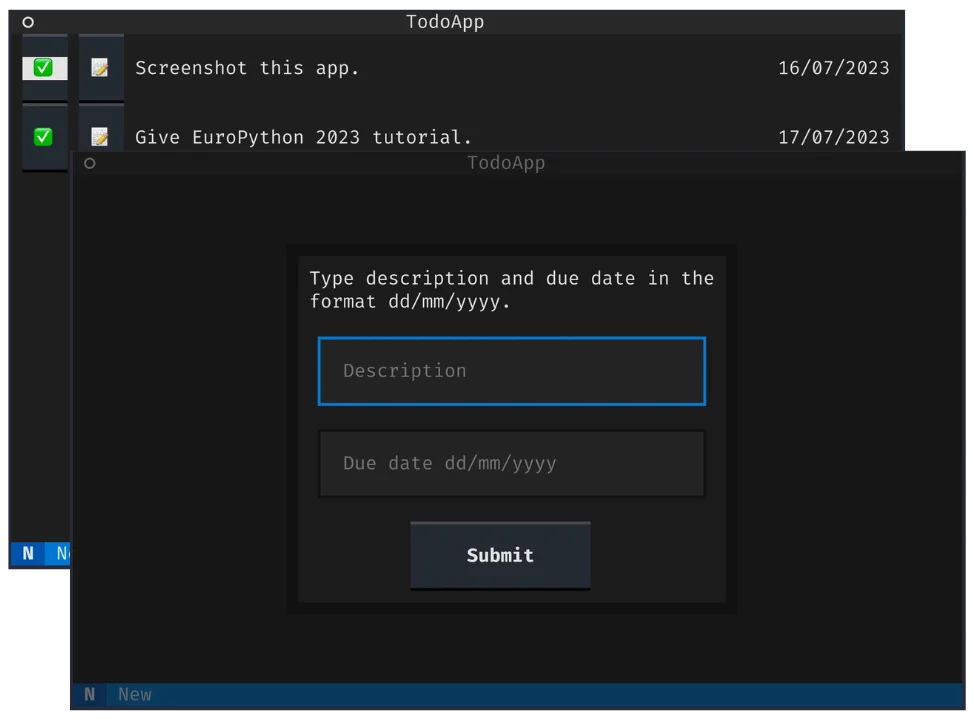
Introduction
This tutorial will teach you the basics that you need to use Textual to build terminal user interfaces (TUIs).
This is an unofficial written version of a tutorial I gave at EuroPython 2023 in Prague.
In case you don't know what Textual is, go ahead and read the description below. Otherwise, let's get building!
What is Textual?
Textual is a Python framework that lets users build applications that run directly in the terminal. Quoting the Textual documentation, some of the advantages of using Textual to build applications include:
- Rapid development: you can use your existing Python skills to build a beautiful user interface. You don't need to learn new languages to write user interfaces.
- Low requirements: you can run Textual on a single board computer if you want to.
- Cross-platform: Textual runs just about everywhere you can run Python.
- Remote: Textual apps can run over SSH.
- CLI integration: Textual apps can be launched and run from the command prompt.
- Open source: Textual is licensed under MIT.
Setup
To get ready for this tutorial, create a new folder, create a new virtual environment, and install Textual!
~:$ mkdir textual-tutorial
~:$ cd textual-tutorial
~/textual-tutorial:$ python -m venv .venv
~/textual-tutorial:$ . .venv/bin/activate
~/textual-tutorial:$ python -m pip install textualTo verify that the installation was successful, run the command
~/textual-tutorial:$ python -m textualThat should open the Textual demo app. It should look something like this:
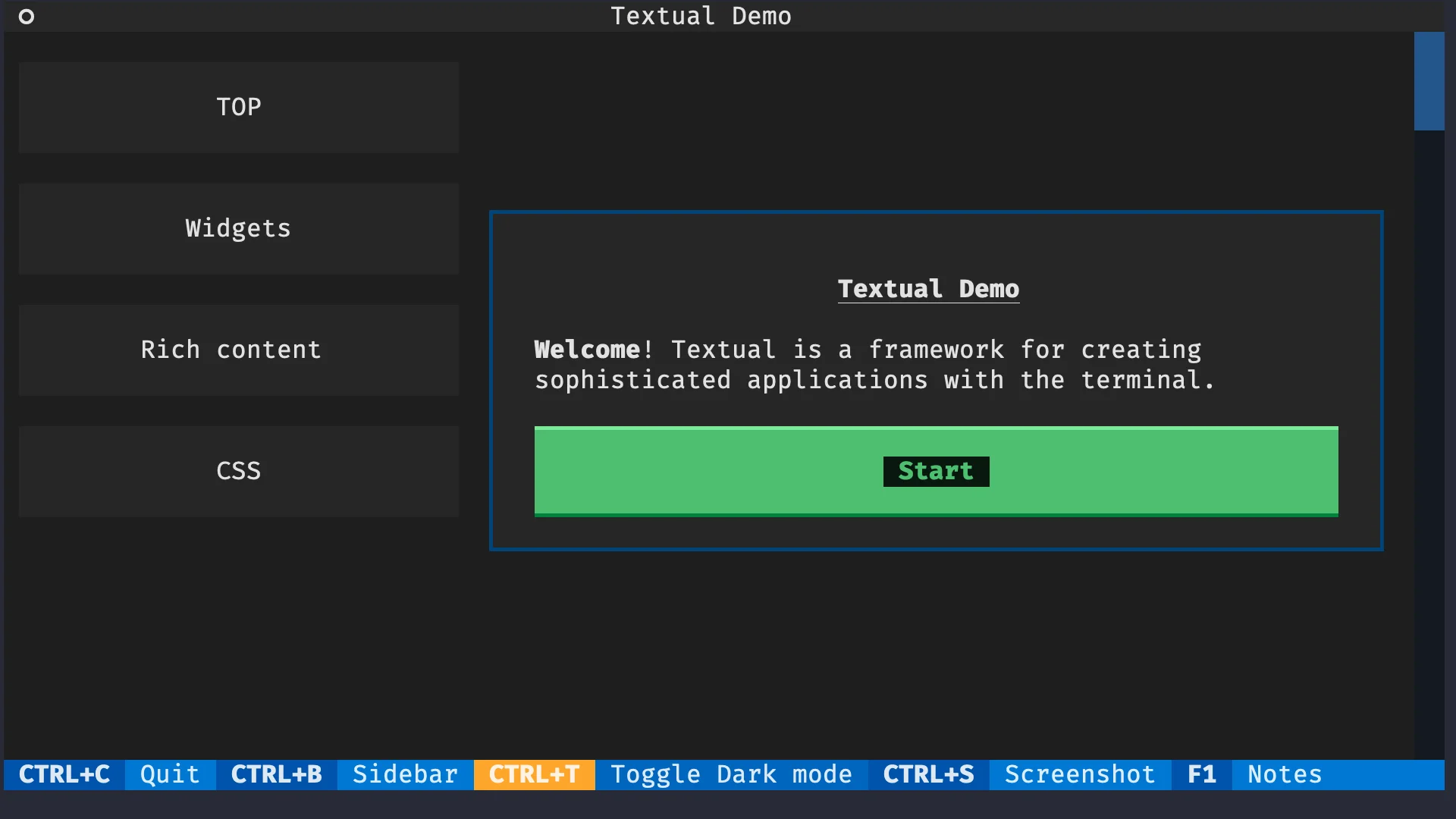
To quit the app, press Ctrl + C.
This tutorial was written for Textual 0.29.0. Some information in this tutorial may become outdated. Check the Textual docs for updated information and join the Textual Discord to talk to us.
Your first Textual app
Textual lets you build TUIs – terminal user interfaces. These are programs that provide an interface for the user to interact with, but they run inside the terminal.
In Textual, the program that shows things to the user and with which the user interacts is called an app. Let us see how to build your first, most basic app.
An application, in Textual, is a class that inherits from textual.app.App.
Then, to run your app, you need to instantiate it and call its method run:
from textual.app import App
class MyApp(App):
pass
MyApp().run()Run your app with the command:
~:$ python your_first_app.pyIt should show a black screen, which means your app is running! It does nothing, but it is running! To exit your app, press Ctrl + C.
Showing widgets on the screen
For your app to do something useful, you will want to add widgets to it. Widgets are the interface elements that the user interacts with and that you can use to convey information to the user.
Textual has an extensive widget library that includes:
- app headers and footers;
- labels;
- buttons;
- inputs;
- radio buttons and checkboxes;
- switches;
- tabs;
- etc.
Composing widgets
Now I will show you how to use widgets in your apps. We will start by adding a header and a button to our app. To add the widgets to the app we need to import them:
from textual.widgets import Button, HeaderNext, we need to know how to tell Textual to display the widgets inside our app.
We do this via the App.compose method, which must return an iterable of widgets.
For ease of use, it is recommended that you yield your widgets one at a time:
from textual.app import App
from textual.widgets import Button, Header
class MyApp(App):
def compose(self):
yield Header()
yield Button()
MyApp().run()If you run this app, you should see an app with a header with the title “MyApp” and a button with the text “Button”, like the image below shows:
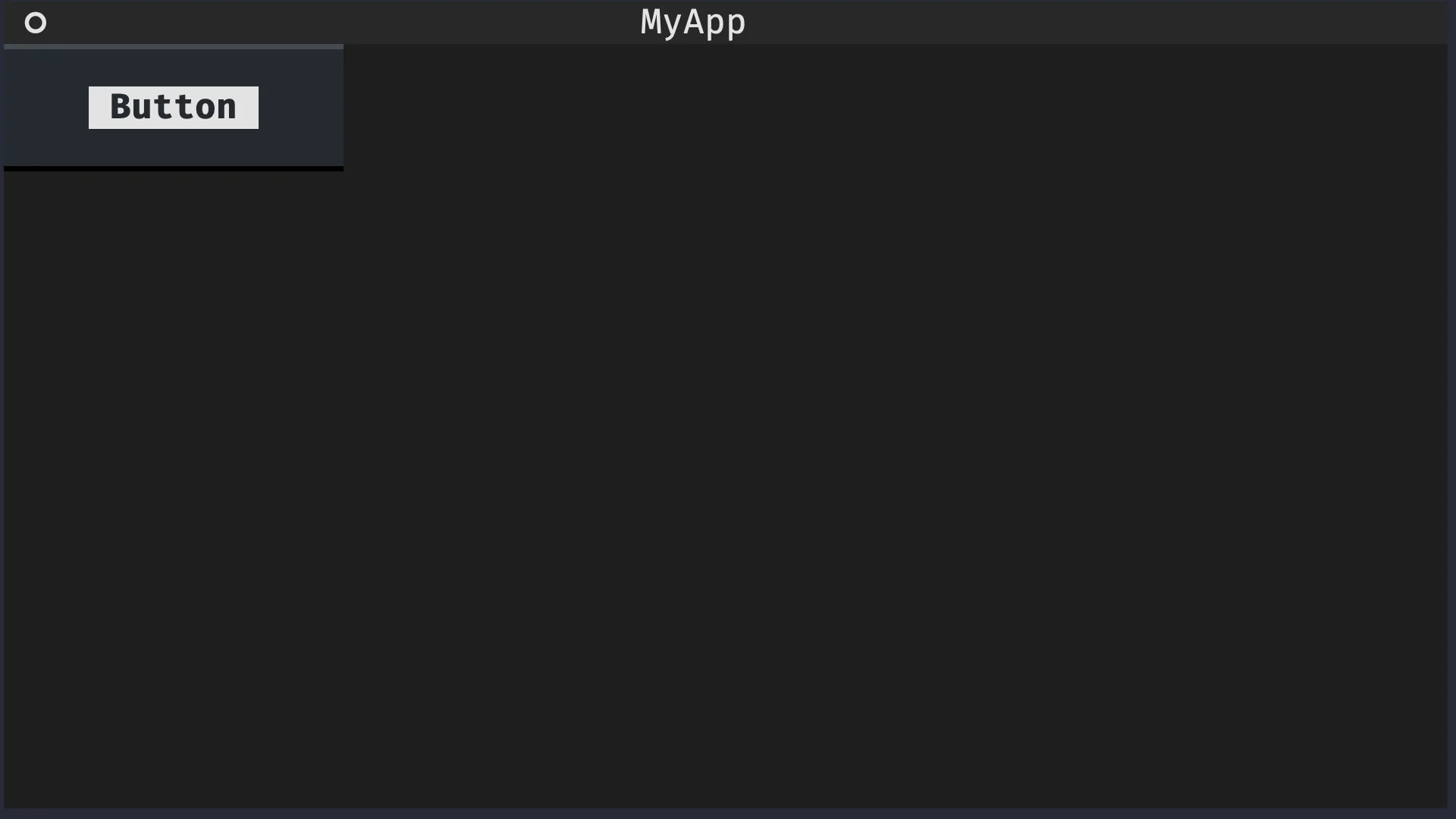
Customising widgets upon instantiation
Many widgets can be customised when they are instantiated. For example, the header can be set to show a clock with the current time and a button can have a non-default text:
from textual.app import App
from textual.widgets import Button, Header
class MyApp(App):
def compose(self):
yield Header(show_clock=True)
yield Button("Click me!")
MyApp().run()If you run the app now, you will see a clock in the upper right corner and you will see the text “Click me!” inside the button:
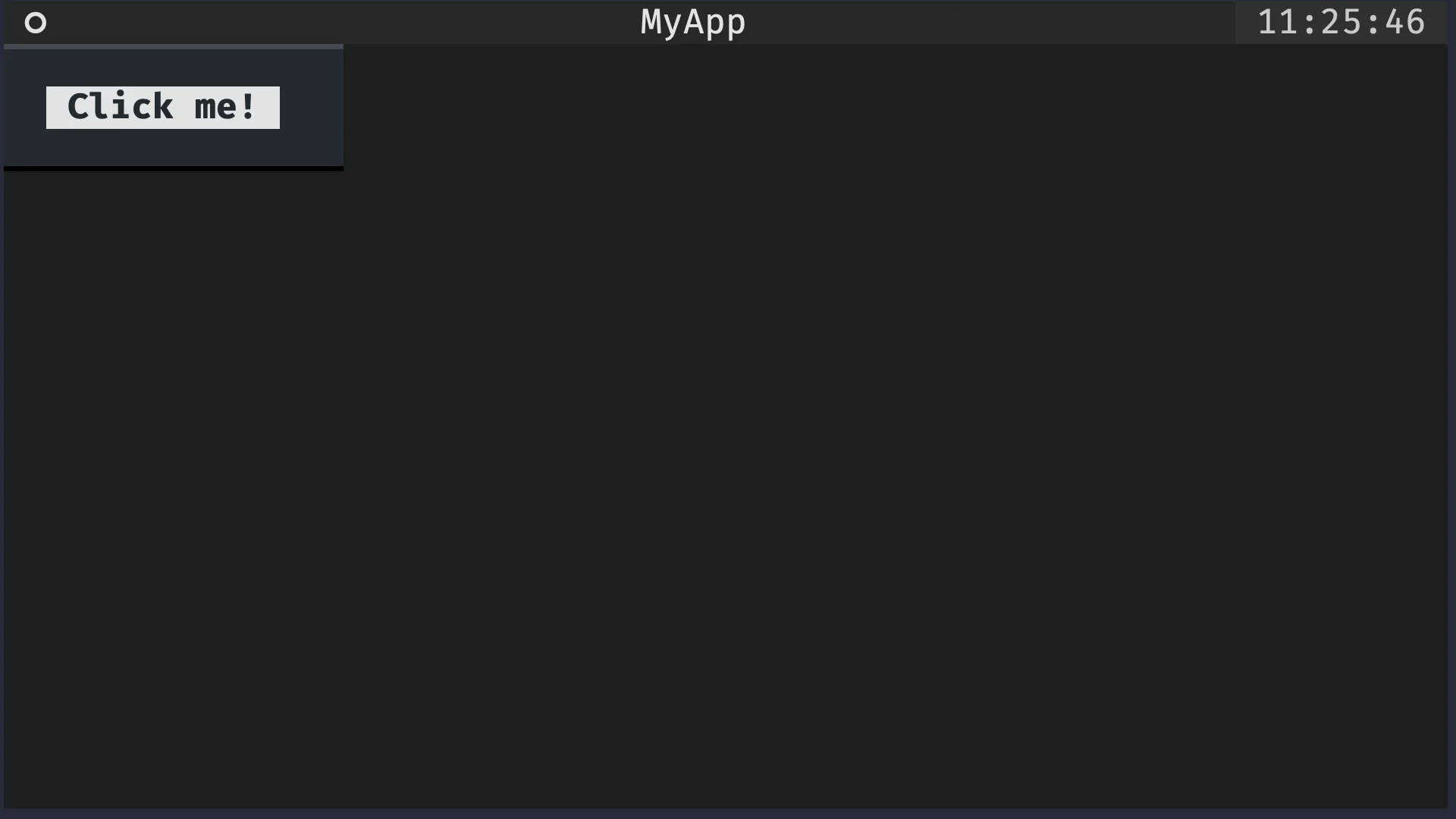
Adding inputs to your app
Go to the Textual widgets reference and figure out how to include an input field in your app.
Customise it so that it has some placeholder text saying “Name:”.
Do this by locating the Input widget in the reference and looking at the subsection “A Simple Example”.
The solution to this is to add the widget Input to the import list and then yield it inside the method MyApp.compose.
Additionally, the widget Input has a parameter placeholder that can be used to specify the placeholder text of the input field in the app:
from textual.app import App
from textual.widgets import Button, Header, Input
class MyApp(App):
def compose(self):
yield Header(show_clock=True)
yield Button("Click me!")
yield Input(placeholder="Name:")
MyApp().run()This app looks like this:
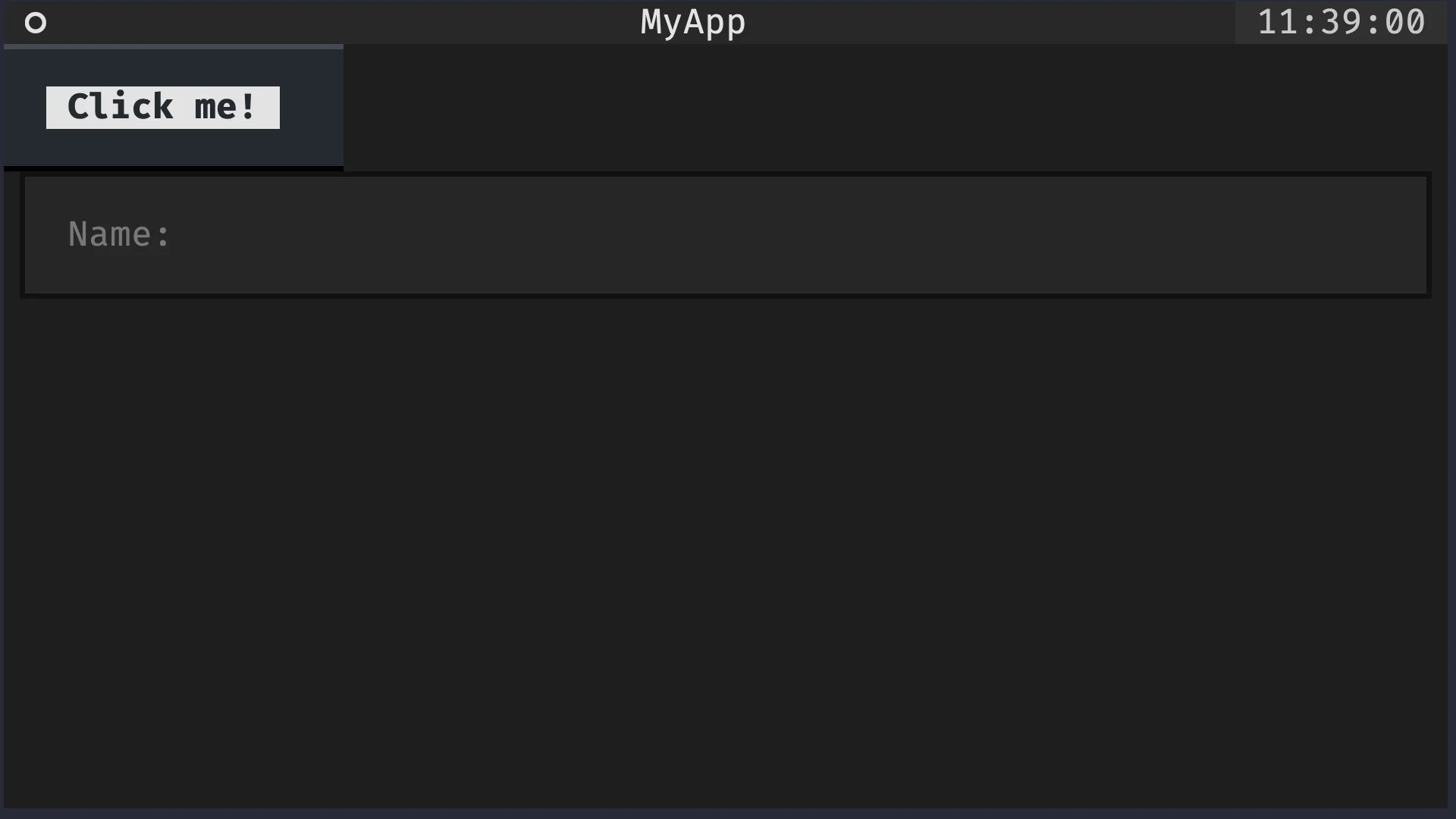
Try swapping the lines yield Button(...) and yield Input(...) to see what difference that makes.
Compound widgets
Rationale
When building applications, it is common to group some fundamental widgets to create a more complex widget that has a particular significance in your app. For example, we can modify the previous application to include a label next to the input field:
from textual.app import App
from textual.widgets import Button, Header, Input, Label
class MyApp(App):
def compose(self):
yield Header(show_clock=True)
yield Label("Name:")
yield Input(placeholder="name")
yield Button("Click me!")
MyApp().run()If you extend your application to also ask for the user's surname and email, you will likely want to repeat the pattern:
- a label and an input for the surname; and
- a label and an input for the email.
Something along these lines:
from textual.app import App
from textual.widgets import Button, Header, Input, Label
class MyApp(App):
def compose(self):
yield Header(show_clock=True)
yield Label("Name:")
yield Input(placeholder="name")
yield Label("Surname:")
yield Input(placeholder="surname")
yield Label("Email:")
yield Input(placeholder="email")
yield Button("Click me!")
MyApp().run()As we notice the pattern, we may extract it and implement a widget called LabelledInput that is composed of a label and a related input.
When we put together two or more widgets to create a more complex widget, we say we build a compound widget.
Defining a compound widget
Compound widgets are regular widgets, but instead of having to implement their functionality from scratch, you can use other widgets as a starting point. To do this, you need to create the class that is going to represent your compound widget.
Much like you inherited from textual.app.App to create your own app, you will need to inherit from textual.widget.Widget to create your own widget:
from textual.widget import Widget
class LabelledInput(Widget):
passThis prepares LabelledInput to become a compound widget.
What is left is specifying what this compound widget is composed of.
Similarly to apps, compound widgets can have a method compose that specifies what are the widgets that make it up.
In the case of our LabelledInput, it will be composed of a label and an input:
from textual.widget import Widget
from textual.widgets import Input, Label
class LabelledInput(Widget):
def compose(self):
yield Label("Label:")
yield Input(placeholder="label")Using a compound widget
Compound widgets are used like any other widget.
For instance, you can yield it inside the method compose of your app:
from textual.app import App
from textual.widget import Widget
from textual.widgets import Button, Header, Input, Label
class LabelledInput(Widget):
def compose(self):
yield Label("Label:")
yield Input(placeholder="label")
class MyApp(App):
def compose(self):
yield Header(show_clock=True)
yield LabelledInput() # !!!
yield Button("Click me!")
MyApp().run()If you run this app, it will look like the button disappeared:

However, if you look closely, you will notice a scrollbar on the right that lets you scroll until you see the button.
This odd behaviour is explained by the fact that Widget, which LabelledInput inherits from, is too tall by default.
The full discussion about Textual CSS will only happen later down the road, but you will get a quick taste now.
Textual CSS is a markup language that you can use to modify the way your widgets look.
In this particular case, we want the LabelledInput widgets to have a much smaller height, so that is what we will do.
Here is the updated compound widget, with 5 new lines of code:
from textual.app import App
from textual.widget import Widget
from textual.widgets import Button, Header, Input, Label
class LabelledInput(Widget):
DEFAULT_CSS = """
LabelledInput {
height: 4;
}
"""
def compose(self):
yield Label("Label:")
yield Input(placeholder="label")
class MyApp(App):
def compose(self):
yield Header(show_clock=True)
yield LabelledInput()
yield Button("Click me!")
MyApp().run()The class variable DEFAULT_CSS is responsible for specifying that the height of the widget LabelledInput should be 4, instead of whatever value was set before.
This app now has the look that we expected:
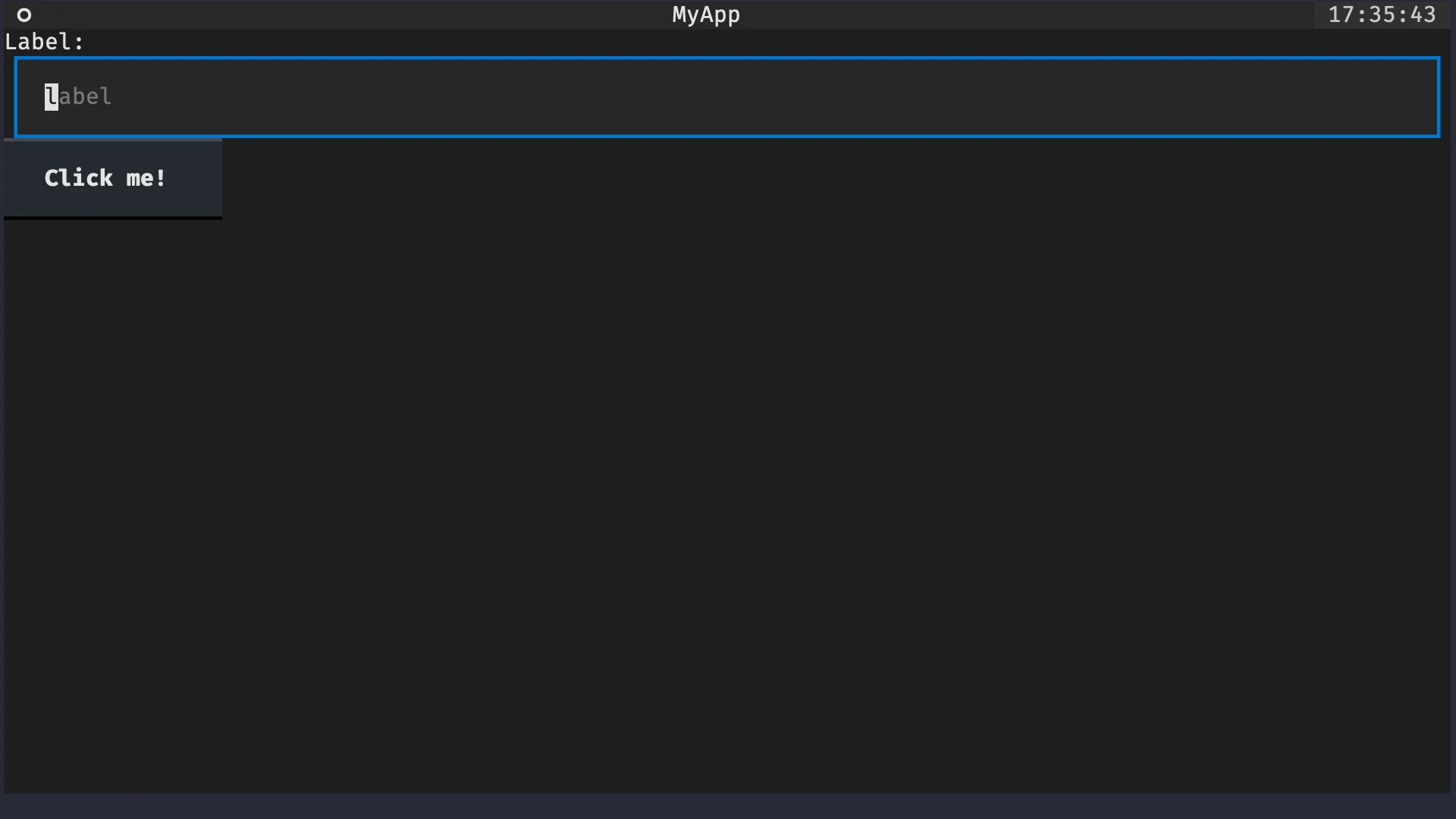
Try playing around with the value in front of height: to see how the look of the app changes when that value changes.
Customising a compound widget upon instantiation
Like all other widgets, compound widgets can also be customised upon instantiation. Given that a compound widget contains sub-widgets, it is common for some of the customisation options of said sub-widgets to be exposed by the compound widget itself.
For our LabelledInput example, we will let the user customise the text inside the label:
## ...
class LabelledInput(Widget):
DEFAULT_CSS = """
LabelledInput {
height: 4;
}
"""
def __init__(self, label):
super().__init__() # <- SUPER important.
self.label = label
def compose(self):
yield Label(f"{self.label}:")
yield Input(placeholder=self.label.lower())When overriding the dunder method __init__ of your compound widget, be particularly careful about calling super().__init__()!
If you forget that, you will get all sorts of funny errors when using your compound widget inside an app.
With this improved version of LabelledInput, we can now reproduce the form we had before:
from textual.app import App
from textual.widget import Widget
from textual.widgets import Button, Header, Input, Label
class LabelledInput(Widget):
DEFAULT_CSS = """
LabelledInput {
height: 4;
}
"""
def __init__(self, label):
super().__init__()
self.label = label
def compose(self):
yield Label(f"{self.label}:")
yield Input(placeholder=self.label.lower())
class MyApp(App):
def compose(self):
yield Header(show_clock=True)
yield LabelledInput("Name")
yield LabelledInput("Surname")
yield LabelledInput("Email")
yield Button("Click me!")
MyApp().run()This application looks like this:

Key bindings and actions
In Textual, you can bind key presses to methods in your application. To “bind” a key press means that you can automatically call a given method when the user presses a certain key or a set of keys. For example, you could make it so that pressing Esc quits your application or pressing Ctrl + D toggles dark mode.
Textual allows such bindings via actions. More precisely, via action methods.
Action methods
Action methods are regular app methods that follow a naming convention.
An action method should start with action_.
In the app below, the method action_ring_a_bell is an action method:
from textual.app import App
class MyApp(App):
def action_ring_a_bell(self):
self.bell()
MyApp().run()The action method action_ring_a_bell implicitly defines an action called ring_a_bell, which is what comes after action_ in the method name.
Now, we need to tell Textual that the action ring_a_bell should be triggered when the user presses the key B.
Declaring a binding
Applications have a class variable BINDINGS that can be used to bind keys to actions.
In its simplest form, the class variable BINDINGS is a list of tuples, each tuple declaring a binding.
To bind the key B to the action ring_a_bell, all we need is the tuple ("b", "ring_a_bell"):
from textual.app import App
class MyApp(App):
BINDINGS = [("b", "ring_a_bell")]
def action_ring_a_bell(self):
self.bell()
MyApp().run()If you run this app and press B, you should hear the system bell. This means you successfully created your first key binding! Take a moment to celebrate! Turn the volume of your computer up and hit the key B repeatedly!
Action naming
Just to be clear, Textual does not care about the specific name that you give to your action.
The only thing that Textual needs is for you to be consistent across the declaration of the class variable BINDINGS and the name of your action method.
For example, we could simplify the action name to bell:
from textual.app import App
class MyApp(App):
BINDINGS = [("b", "bell")]
# vvvv ^^^^
def action_bell(self):
self.bell()
MyApp().run()Display actions in the footer
In order to let the user know which key bindings are available, Textual provides the widget Footer.
The widget Footer will show the key bindings at the bottom of your application.
For that, you need two things:
- you need to add the widget
Footerto your app; and - you need to add a description to your key binding.
In the class attribute BINDINGS, the description of a key binding is the third element of the tuple that defines the binding.
So, if we revisit the previous example, the code below will display the footer widget which will contain an indication that the key B will ring a bell:
from textual.app import App
from textual.widgets import Footer
class MyApp(App):
BINDINGS = [("b", "bell", "Ring")]
def compose(self):
yield Footer()
def action_bell(self):
self.bell()
MyApp().run()The image below shows what the footer looks like:
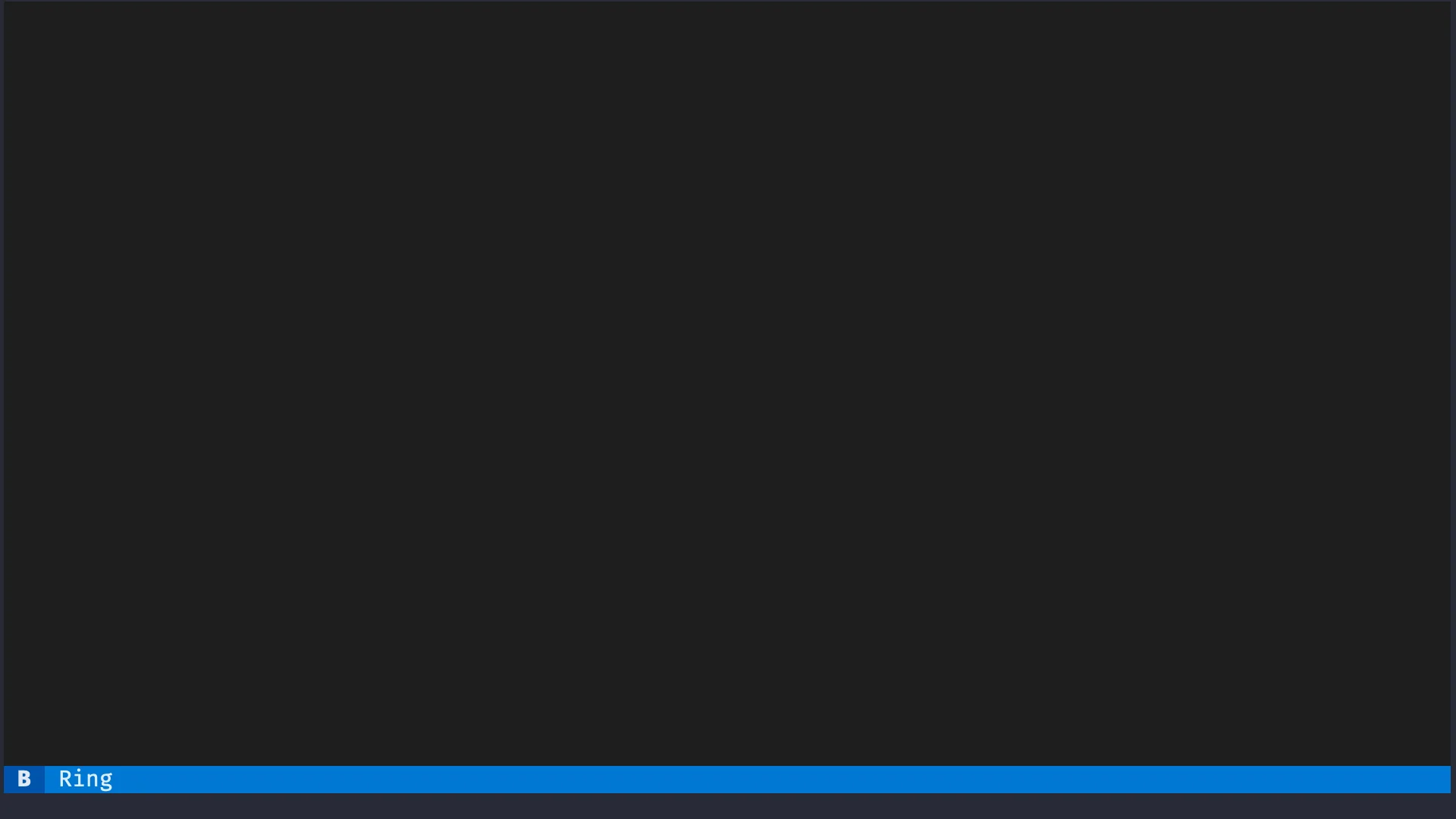
Dynamic widget creation
So far, the only widgets we had in our apps were instantiated inside the method compose.
However, widgets can also be added dynamically to your app.
You do this by calling the app method mount.
For example, we can modify the previous key binding to add a label to the application whenever the key B is pressed:
from textual.app import App
from textual.widgets import Footer, Label
class MyApp(App):
BINDINGS = [("b", "bell", "Ring")]
def compose(self):
yield Footer()
def action_bell(self):
self.bell()
self.mount(Label("Ring!"))
MyApp().run()If you run this application and press B a couple of times, you should see some labels with the text “Ring!” show up, as the next image shows:
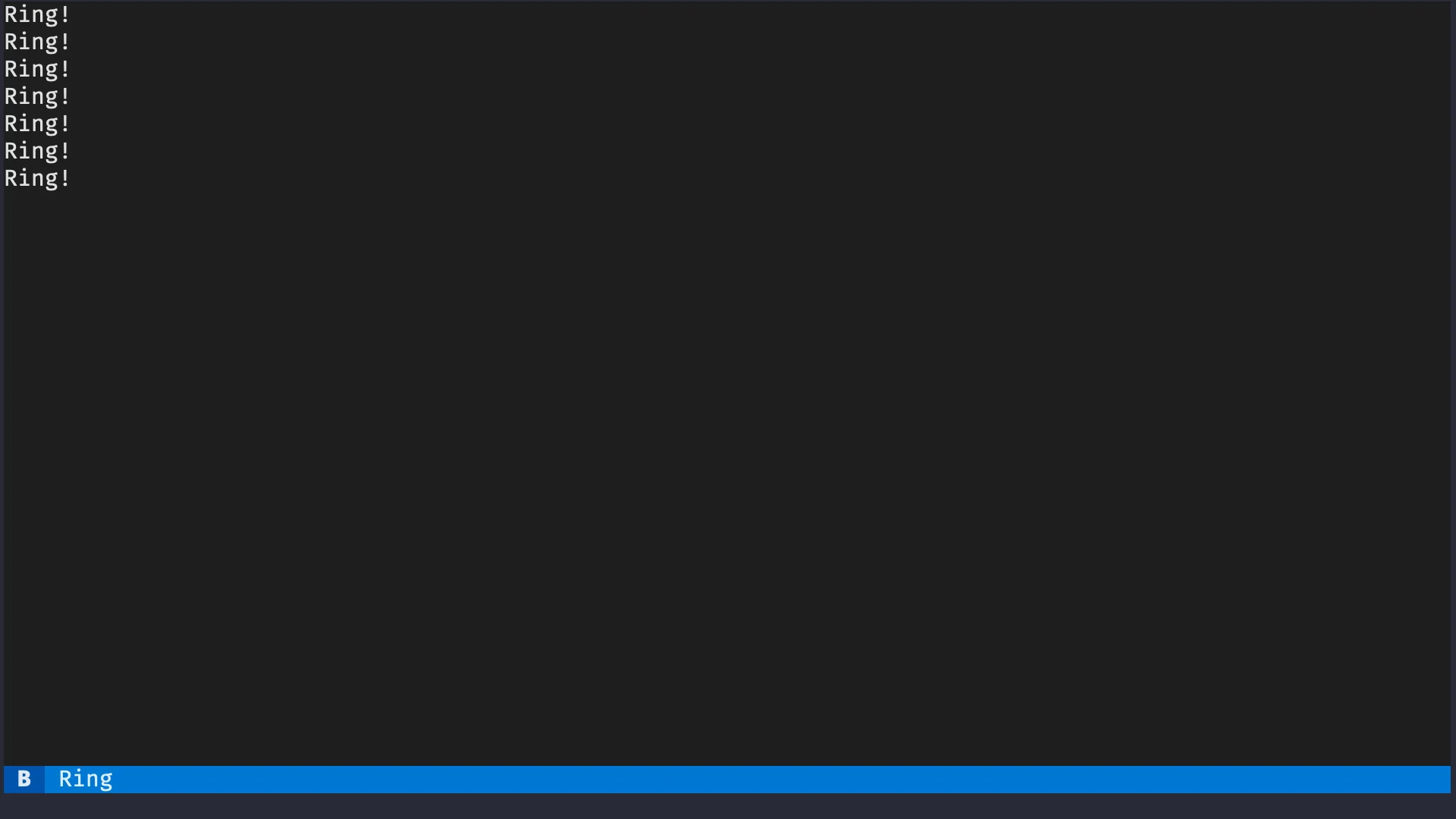
Build your first TODO app prototype
Quick recap
Take a moment to stretch, you already learned a lot! Here is a quick recap of the things you already know:
- Textual applications are created by inheriting from
textual.app.App; - the app method
composeis responsible for putting widgets on the screen; - the best way to use the method
composeis by yielding the widgets you want to put in the app; - widgets can be customised upon instantiation;
- how to create compound widgets by way of using the widget's method
compose; - the class variable
DEFAULT_CSScan be used to control the height of a compound widget; - methods can be bound to key presses via the app's class variable
BINDINGS; - an action method is a method whose name starts with
action_; - key bindings can have a description and then shown in the app widget
Footer; and - you can dynamically add a widget to an app with the app method
mount.
Challenge
I want to challenge you to take everything you learned so far and create your first prototype of the TODO app we will be creating.
Here are the requirements for this challenge:
- your app should have a header and a footer;
- you should define a compound widget called
TodoItemthat is going to represent each entry in your app;- the
TodoItemshould have two labels, one for the description of the item and the other for the due date; and - create the labels inside
TodoItemwith some dummy data like “I should get this done!” for the description and “dd/mm/yyyy” for the date.
- the
- create a key binding so that pressing N creates a new
TodoItemthat gets added to the app.
If you follow all the requirements, run your app, and press N a couple of times, you should get something like this:
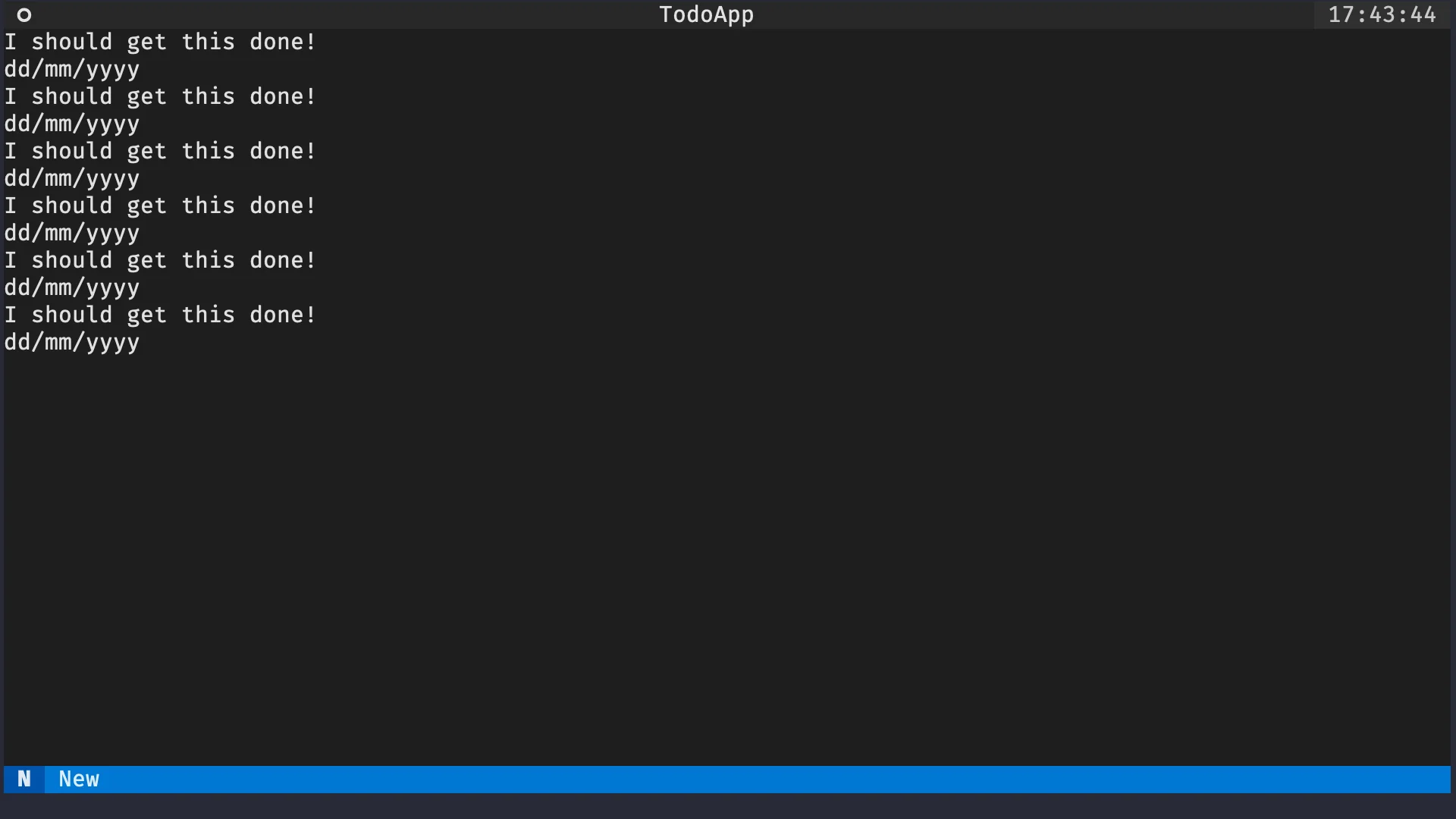
Code for the first prototype
There are multiple ways to implement an application that behaves as defined above. The code below is my proposal:
from textual.app import App
from textual.widget import Widget
from textual.widgets import Footer, Header, Label
class TodoItem(Widget):
DEFAULT_CSS = """
TodoItem {
height: 2;
}
"""
def compose(self):
yield Label("I should get this done!")
yield Label("dd/mm/yyyy")
class TodoApp(App):
BINDINGS = [("n", "new_item", "New")]
def compose(self):
yield Header(show_clock=True)
yield Footer()
def action_new_item(self):
self.mount(TodoItem())
TodoApp().run()Layout containers
One thing that you probably noticed already is that all the widgets we have been creating and composing are getting stacked vertically. However, there are times when we would prefer widgets stacked horizontally. We will learn to do this with containers.
In Textual, a container is a widget that groups many widgets. Typically, Textual containers provide a bit of extra functionality on top of the grouping.
For example, the containers Horizontal and Vertical change how their child widgets get stacked.
A container is used like a context manager and inside the context manager you just have to yield the children of that container.
The app below gives an example:
from textual.app import App
from textual.containers import Horizontal
from textual.widgets import Label
class MyApp(App):
def compose(self):
yield Label("first label!")
with Horizontal():
yield Label("second label.")
yield Label("third label...")
MyApp().run()If you run this app, you will see the first label on a line of its own. The second and third labels, which are now side-by-side, will be under the first one. The image below shows this:
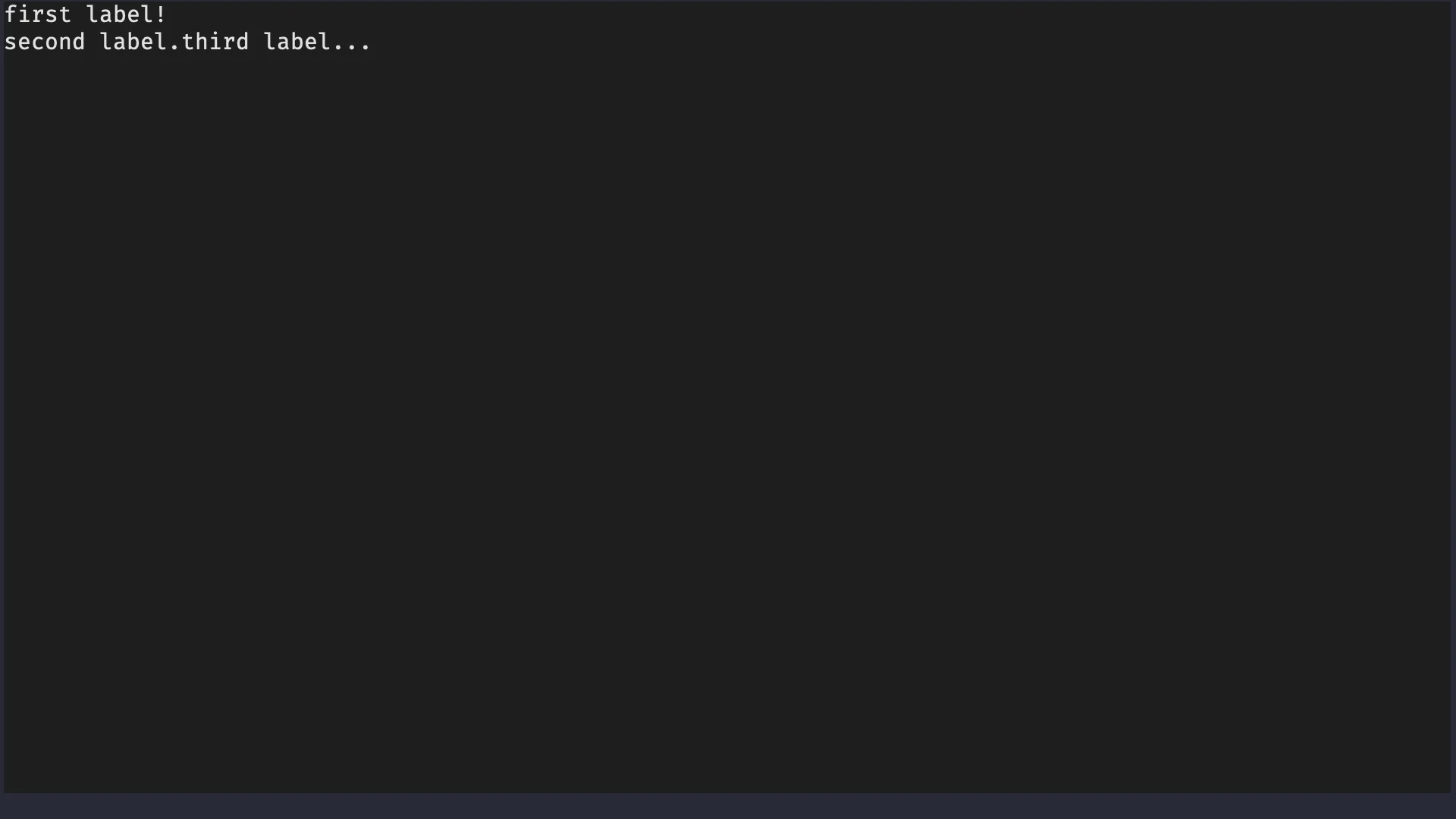
Messages and message handling
What are Textual messages?
Messages are how Textual notifies the app that something occurred. For example, when the user presses a button, Textual issues a message for that. If you want your application to do something whenever the user presses a button, you need to handle that message.
Many built-in widgets define useful messages that are classes defined inside the widget namespace. For example,
- for the widget
Button, the message that is sent when the button is pressed isButton.Pressed; and - for the widget
Input, the message that is sent when the input value changes isInput.Changed.
Built-in widgets have all of their messages listed in the widgets reference.
For example, if you open the widget Button reference you will find the Button.Pressed message.
What is left is knowing how to handle such messages.
Handler methods
When a message is posted – such as the message Button.Pressed when the user presses a button – Textual will look for a special method called a handler method.
Such a handler method is a regular Python method with a special naming convention.
If you implement a method called on_button_pressed, Textual will call that method whenever a button is pressed.
To test this out, we can create a simple app with a single button and a method called on_button_pressed that will play the app bell.
Here it is:
from textual.app import App
from textual.widgets import Button
class MyApp(App):
def compose(self):
yield Button("Ring")
def on_button_pressed(self):
self.bell()
MyApp().run()Try running your app and pressing the button. You should hear a bell.
Handler method naming
A handler method is any method that follows this naming convention:
- the name starts with
on_; and - the name ends with the message namespace and message name in snake case.
Here are two examples of handler methods:
- The message
Button.Pressedis associated with button presses and it can be handled by a method calledon_button_pressed. - The message
Input.Changedis associated with changes to an input field and it can be handled by a method calledon_input_changed.
Try implementing a handler method for the message Input.Changed that also calls the app bell.
If you do it correctly, you should hear a bell whenever you type inside your app's input field.
We can do this if we yield an input inside compose and if we implement a method called on_input_changed:
from textual.app import App
from textual.widgets import Button, Input
class MyApp(App):
def compose(self):
yield Button("Ring")
yield Input()
def on_button_pressed(self):
self.bell()
def on_input_changed(self):
self.bell()
MyApp().run()Custom messages
You can also create custom messages by inheriting from textual.message.Message.
Custom messages are especially useful when you create your own (compound) widgets.
Messages are the correct way for widgets to communicate with the app. Thus, if we want to be able to edit and dismiss TODO items, we will need custom messages for that.
Create a message
Creating a message can be as simple as just inheriting from Message:
from textual.message import Message
class Ring(Message):
passThe code above defines a new message Ring.
Now, we need to see how to use this message.
Posting a message
In Textual, we talk about posting messages, which essentially means that widgets and apps get notified of things.
If you have a message that you would like to propagate, you can call the method post_message on the widget/app that should receive the notification.
For example, whenever the user presses the button of the app below, the app is notified of the message Ring.
from textual.app import App
from textual.message import Message
from textual.widgets import Button
class Ring(Message):
pass
class MyApp(App):
def compose(self):
yield Button("Ring")
def on_button_pressed(self):
self.post_message(Ring())
MyApp().run()Handling custom messages
You can handle custom messages in the same way as you would handle a built-in message. All you need to do is follow the naming convention.
The message Ring is not nested inside anything, so its handler method is called on_ring.
If we add that method to the app, now the app rings whenever the button is pressed:
from textual.app import App
from textual.message import Message
from textual.widgets import Button
class Ring(Message):
pass
class MyApp(App):
def compose(self):
yield Button("Ring")
def on_button_pressed(self):
self.post_message(Ring())
def on_ring(self):
self.bell()
MyApp().run()Custom messages inside compound widgets
When compound widgets need custom messages, those are typically defined inside the widget, much like the message Pressed for buttons is actually defined inside Button.
Supposing that we had a custom widget RingerWidget, then we could move the message Ring inside that widget:
from textual.message import Message
from textual.widget import Widget
class RingerWidget(Widget):
class Ring(Message):
passBy doing so, the handler method for the message RingerWidget.Ring now becomes on_ringer_widget_ring.
Self-removing widget
Much like you can add widgets dynamically to your application, you can also remove them.
To do this, all you need to do is call the method remove on the widget.
We will use this method to implement a widget that requests its own deletion. To achieve this, we will also need to use a custom message. Here is the whole flow for this pattern:
- the compound widget posts a message to request deletion;
- the deletion request holds a reference to the widget that wants to be deleted; and
- the app handles the deletion request by calling the method
remove.
Here is the implementation of this pattern:
from textual.app import App
from textual.message import Message
from textual.widget import Widget
from textual.widgets import Button
class Deletable(Widget):
class DeletionRequest(Message):
def __init__(self, to_delete):
super().__init__()
self.to_delete = to_delete
def compose(self):
yield Button("Delete me.")
def on_button_pressed(self):
self.post_message(Deletable.DeletionRequest(self))
class MyApp(App):
def compose(self):
yield Deletable()
def on_deletable_deletion_request(self, message):
message.to_delete.remove()
MyApp().run()This may sound like a convoluted pattern.
For example, why don't we just do self.remove() inside Deletable.on_button_pressed?
Unless the only purpose of your widget is to delete itself, you are better off delegating the deletion of the widget to the app. By using a custom message, you give the app a chance to react to the deletion request and handle it in the best way. For example, you may need to perform some cleanup before/after deleting the widget.
Reactive attributes
A reactive attribute is a Textual mechanism that lets you react to attribute changes.
Automatic UI updates
For example, the app below rings a bell whenever the attribute counter is increased.
To do this, we define counter at the class level as a reactive instance and we implement a special method:
from textual.app import App
from textual.reactive import reactive
from textual.widgets import Button
class MyApp(App):
counter = reactive(0)
def compose(self):
yield Button("+1")
def on_button_pressed(self):
self.counter += 1
def watch_counter(self):
self.bell()
MyApp().run()The line counter = reactive(0) sets the attribute counter to a reactive attribute and initialises it with the value 0.
The method watch_counter is a watch method.
A watch method is a regular method that follows the naming convention of starting with the prefix watch_.
When the reactive attribute counter = reactive(0) is changed, Textual will look for an associated watch method and it will call it.
In this case, the associated watch method is watch_counter.
If the reactive attribute were named foo, then the watch method would be watch_foo.
The naming scheme is similar to that of actions.
A slightly more interesting variation of the app above uses a label to display the value of the counter.
We just need to use the method update to update the value that the label is displaying:
from textual.app import App
from textual.reactive import reactive
from textual.widgets import Button, Label
class MyApp(App):
counter = reactive(0)
def compose(self):
self.label = Label()
yield self.label
yield Button("+1")
def on_button_pressed(self):
self.counter += 1
def watch_counter(self):
self.label.update(str(self.counter))
MyApp().run()Notice how we save a reference to the label inside the method compose so that we can refer to it inside watch_counter.
If you run this app and you press the button repeatedly, you will see the value of the label increase, like the animation below shows:

Reactive attribute lifecycle
Reactives warrant a warning, though. Watch methods of reactive attributes will often interact with other widgets, possibly other reactive attributes, etc. This means that you need to make sure that those things already exist when you assign to the reactive attribute the first time.
For instance, if your reactive attribute needs to interact with other widgets, those widgets are typically initialised inside the method __init__.
Thus, a safer version of the previous app would be the following:
from textual.app import App
from textual.reactive import reactive
from textual.widgets import Button, Label
class MyApp(App):
counter = reactive(0)
def __init__(self):
self.label = Label()
super().__init__()
def compose(self):
yield self.label
yield Button("+1")
def on_button_pressed(self):
self.counter += 1
def watch_counter(self):
self.label.update(str(self.counter))
MyApp().run()Decorator on
The decorator on is a convenience decorator that you can use to declare arbitrary message handlers that don't follow the message handling naming convention.
For example, in the previous app, we could have written a method increment_counter that increments the counter:
def increment_counter(self):
self.counter += 1Then, we could have used the decorator on to say that that method should be called whenever the message Button.Pressed is posted.
Here is how you would do it, after importing the decorator on from textual:
from textual import on # !!!
from textual.app import App
from textual.reactive import reactive
from textual.widgets import Button, Label
class MyApp(App):
counter = reactive(0)
def compose(self):
self.label = Label()
yield self.label
yield Button("+1")
@on(Button.Pressed) # !!!
def update_counter(self):
self.counter += 1
def watch_counter(self):
self.label.update(str(self.counter))
MyApp().run()For such a simple use case, the decorator on isn't particularly advantageous when compared to the message handling naming convention.
However, there is another scenario in which the decorator on becomes an excellent alternative.
Motivation for the decorator on
We want to extend the previous app to include buttons that increment the counter by 10 and by 100. We can add those buttons to the app easily:
from textual import on
from textual.app import App
from textual.reactive import reactive
from textual.widgets import Button, Label
class MyApp(App):
counter = reactive(0)
def compose(self):
self.label = Label()
yield self.label
yield Button("+1")
yield Button("+10")
yield Button("+100")
@on(Button.Pressed) # !!!
def increment_counter(self):
self.counter += 1
def watch_counter(self):
self.label.update(str(self.counter))
MyApp().run()However, regardless of the button you press, the counter only increases by 1:
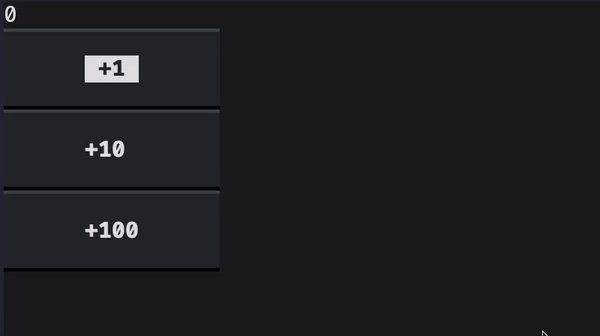
We need to be able to tell the buttons apart and then we need to increment the counter accordingly.
Widget identifiers
To tell the buttons apart, we can assign a unique identifier to each one of them:
## ...
class MyApp(App):
counter = reactive(0)
def compose(self):
self.label = Label()
yield self.label
yield Button("+1", id="one")
yield Button("+10", id="ten")
yield Button("+100", id="hundred")
## ...Then, we can use the optional parameter of the decorator on to specify that a given method should only be called if we get a message Button.Pressed from the button with the given identifier:
## ...
class MyApp(App):
counter = reactive(0)
def compose(self):
self.label = Label()
yield self.label
yield Button("+1", id="one")
yield Button("+10", id="ten")
yield Button("+100", id="hundred")
@on(Button.Pressed, "#one")
def plus_one(self):
self.counter += 1
@on(Button.Pressed, "#ten")
def plus_ten(self):
self.counter += 10
@on(Button.Pressed, "#hundred")
def plus_hundred(self):
self.counter += 100
## ...Notice that, to filter the buttons by their identifier inside the decorator on, we need to prefix the identifier with the character #.
There is a reason for this and that reason should become clear when you learn about Textual CSS.
Modal screens
A Textual screen is like a page in your application. Different screens can have different purposes.
In our TODO app, we are going to have the main screen that shows all the pending TODO items and we are going to have a second screen where the user can fill in the details (description and date) of a TODO item.
We will use modal screens for this because, if I'm being honest, modal screens look really cool.
Creating a modal screen
Creating a modal screen is essentially like creating a compound widget or an app:
you need to create a class that inherits from textual.screen.ModalScreen and then you use the method compose to determine what widgets go up on that screen.
The class MyModalScreen implements a modal screen with a button:
from textual.screen import ModalScreen
from textual.widgets import Button, Label
class MyModalScreen(ModalScreen):
def compose(self):
yield Label("My modal screen")
yield Button("Exit")Showing a modal screen
Custom screens are used when you push them with the method push_screen.
The method push_screen will push its argument screen on top of the current interface.
You can push many screens on top of each other and Textual will keep track of the screen stack for you.
To show our modal screen, we will create a barebones app that pushes the modal screen when the app's button is pressed:
from textual.app import App
from textual.screen import ModalScreen
from textual.widgets import Button, Label
class MyModalScreen(ModalScreen):
def compose(self):
yield Label("My modal screen")
yield Button("Exit")
class MyApp(App):
def compose(self):
yield Button("Push modal!")
def on_button_pressed(self):
self.push_screen(MyModalScreen())
MyApp().run()After the modal is pushed, this is what the application looks like:

Styling the modal appropriately
Above I wrote the following: “modal screens look cool”. However, the modal screen I just showed doesn't look that good, but that's straightforward to fix. We just add these four lines to our modal screen class:
from textual.screen import ModalScreen
from textual.widgets import Button, Label
class MyModalScreen(ModalScreen):
# Added this:
DEFAULT_CSS = """
MyModalScreen {
align: center middle;
}
"""
def compose(self):
yield Label("My modal screen")
yield Button("Exit")With this simple addition, that is again a sneak peek into the Textual CSS feature that I'm about to show you, the modal screen immediately looks infinitely better. It doesn't look great yet, but we can already see that what makes the modal screen so nice is the background transparency that lets you see what is under the modal screen, just like the image below shows:
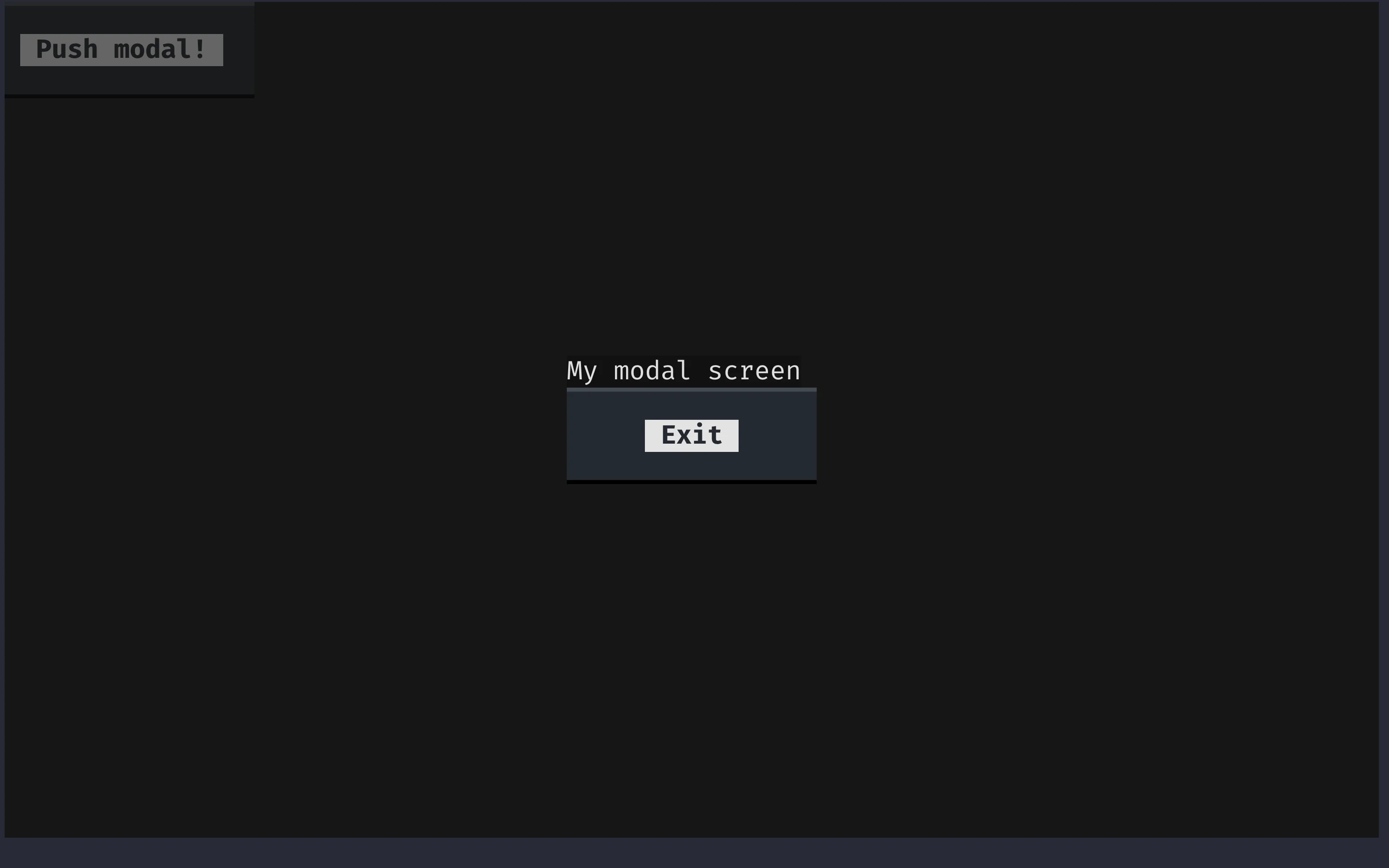
Exiting a modal screen
The main way in which you can exit a modal screen is via the dismiss method.
In our modal screen class, we can add a handler method for the message Button.Pressed and we can dismiss the screen inside that method:
from textual.app import App
from textual.screen import ModalScreen
from textual.widgets import Button, Label
class MyModalScreen(ModalScreen):
DEFAULT_CSS = """
MyModalScreen {
align: center middle;
}
"""
def compose(self):
yield Label("My modal screen")
yield Button("Exit")
def on_button_pressed(self):
self.dismiss()If you run the app now, you can open the modal screen and then you can dismiss it to get back to your application.
Screen callback
The final thing you need to learn about (modal) screens is that they can return results via a callback system.
When you push the screen to the stack with the method push_screen, you can provide an additional argument that is a callback function.
This callback function will be called when you use the method dismiss to leave the screen.
If you pass an argument to dismiss, that argument will be passed into the callback function.
For example, the modal screen below takes note of the timestamp of when it was dismissed and displays it in the main app interface:
import time
from textual.app import App
from textual.screen import ModalScreen
from textual.widgets import Button, Label
class MyModalScreen(ModalScreen):
DEFAULT_CSS = """
MyModalScreen {
align: center middle;
}
"""
def compose(self):
yield Label("My modal screen")
yield Button("Exit")
def on_button_pressed(self):
self.dismiss(time.time()) # <--
class MyApp(App):
def compose(self):
yield Button("Push modal!")
def on_button_pressed(self):
self.push_screen(MyModalScreen(), self.modal_screen_callback) # <--
def modal_screen_callback(self, time): # <--
self.mount(Label(f"Modal dismissed at {time}."))
MyApp().run()Enhance your TODO app prototype
Quick recap
Get up, take a little stroll, and give your eyes and brain a rest. That was plenty of information!
Over the past sections, you learned about:
- layout containers such as
Horizontal; - Textual messages;
- handler methods and the associated naming convention with
on_; - creating custom messages for compound widgets;
- message posting via the method
post_message; - dynamic widget removal via the method
remove; - reactive attributes and watcher methods (
watch_); - the decorator
onto handle messages; - using identifiers to distinguish widgets and their events;
- modal screens and how to create them; and
- getting values from a screen by using a screen callback.
Second challenge
Now, I want you to take the things you just learned, and use them to improve the prototype you have from the first challenge. Bear in mind that the features I will ask you to add to the app do not require many lines of code but they will also not be trivial to implement if you are just starting out with Textual!
So, here are the features I would like for you to add to your app:
- create a modal screen that asks for a description and a date (no need to do parsing/validation for now);
- add two buttons to your TODO item compound widget:
- one to dismiss the TODO item; and
- the other to edit the TODO item.
- use a layout container so that your TODO item compound widget looks better;
- add custom messages that the two buttons should post when they are pressed;
- handle the custom messages in the app so that:
- one of the buttons of the TODO item removes the TODO item from the app; and
- the other button opens the modal to update the TODO item.
- add two reactives to the TODO item, one for the description and another for the due date, so that updating those will in turn update the labels in the widget;
Code for the second iteration
A possible implementation of an app as defined above follows:
from functools import partial
from textual import on
from textual.app import App
from textual.containers import Horizontal
from textual.message import Message
from textual.reactive import reactive
from textual.screen import ModalScreen
from textual.widget import Widget
from textual.widgets import Button, Footer, Header, Input, Label
class TodoItemDetailsScreen(ModalScreen):
DEFAULT_CSS = """
TodoItemDetailsScreen {
align: center middle;
}
"""
def compose(self):
self.description_input = Input(placeholder="description")
self.date_input = Input(placeholder="date")
yield Label("Description:")
yield self.description_input
yield Label("Date:")
yield self.date_input
yield Button("Submit")
def on_button_pressed(self):
data = (self.description_input.value, self.date_input.value)
self.dismiss(data)
class TodoItem(Widget):
DEFAULT_CSS = """
TodoItem {
height: 2;
}
"""
description = reactive("")
date = reactive("")
class Edit(Message):
def __init__(self, item):
super().__init__()
self.item = item
class Delete(Message):
def __init__(self, item):
super().__init__()
self.item = item
def __init__(self):
super().__init__()
self.description_label = Label()
self.date_label = Label()
def compose(self):
with Horizontal():
yield Button("Delete", id="delete")
yield Button("Edit", id="edit")
yield self.description_label
yield self.date_label
def watch_description(self, description):
self.description_label.update(description)
def watch_date(self, date):
self.date_label.update(date)
@on(Button.Pressed, "#edit")
def edit_request(self):
self.post_message(self.Edit(self))
@on(Button.Pressed, "#delete")
def delete_request(self):
self.post_message(self.Delete(self))
class TodoApp(App):
BINDINGS = [("n", "new_item", "New")]
def compose(self):
yield Header(show_clock=True)
yield Footer()
def action_new_item(self):
self.push_screen(TodoItemDetailsScreen(), self.new_item_callback)
def new_item_callback(self, data):
item = TodoItem()
description, date = data
item.description = description
item.date = date
self.mount(item)
def edit_item_callback(self, item, data):
description, date = data
item.description = description
item.date = date
def on_todo_item_delete(self, message):
message.item.remove()
def on_todo_item_edit(self, message):
self.push_screen(
TodoItemDetailsScreen(), partial(self.edit_item_callback, message.item)
)
TodoApp().run()textual-dev
In preparation for the feature you will learn next, Textual CSS, it is recommended that you install the Textual devtools.
The Textual devtools include a command textual that contains many helpful tools for developers writing Textual applications.
If you are currently going through this tutorial inside a virtual environment, installing textual-dev may be as simple as running the command python -m pip install textual-dev.
After you install textual-dev, make sure it worked by running textual --version.
The output should be a version number equal to or above 0.29.0, which is the current version at the time of writing.
Textual CSS
Textual CSS is a feature that I teased a couple of times already and that is fundamental if you want your app to look good. Based on the browser CSS, Textual CSS is a language that allows you to customise the look of your app.
Textual supports dozens of styles, so the purpose of this section is not to go over all of them. This section will show you how to use Textual CSS and you are then free to browse the Textual styles reference to learn about all the styles available and their usage.
Adding CSS to elements
Most of the time, and especially if you are starting out, the best way to add CSS to your app, your screens, and your custom widgets, is via an external CSS file.
Then, you hook the external CSS file to your app via the class variable CSS_PATH.
The path in the class variable CSS_PATH is always taken relative to the path of the file in which the app is defined.
Thus, it is practical and common to have your app file in the same directory as your CSS file.
The app below shows how to define an app that will read its CSS from a file called basic_css.css:
from textual.app import App
from textual.widgets import Label
class MyApp(App):
CSS_PATH = "basic_css.css"
def compose(self):
yield Label("This is some text!")
MyApp().run()Now, it is just a matter of knowing how the Textual CSS syntax works and you are good to go!
Textual CSS syntax
A Textual CSS file is composed of rule blocks. Each rule block is composed of:
- a selector;
- an opening bracket
{; - any number of styles; and
- a closing bracket
}.
The styles are lines of the form style-name: value;, where the style name is as seen in the Textual styles reference and the valid values are also shown there.
A valid CSS block would be:
Label {
background: red;
width: 50%;
content-align-horizontal: right;
}The block above will make sure that all labels have a red background, a width equal to 50% of the width of its container, and the text aligned on the right.
To test this out, save the CSS above in the file basic_css.css and then run your application.
You should see a red label:
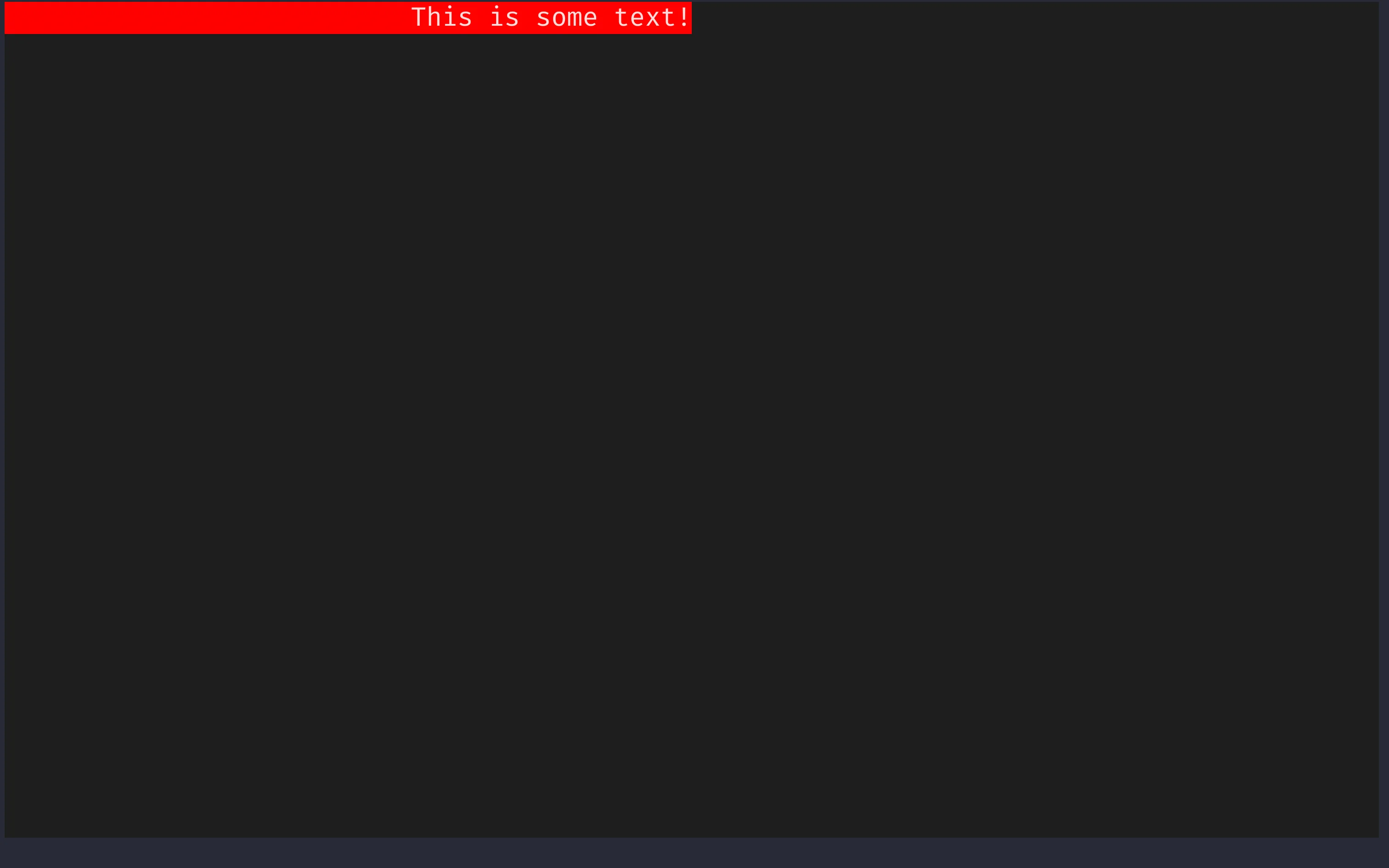
Hot reloading
After having installed textual-dev, you got access to a command textual that has a subcommand run.
The command textual run can be used to run your Textual applications as per usual.
However, if you run the command textual run --dev, then you are running your application in development mode, which enables a very useful feature when you are using Textual CSS:
hot reloading.
If you run your application with textual run --dev app_file.py, if you make changes to the CSS file, and if you save the CSS file, the changes should take effect in the app without having to restart the app.
This is very convenient.
To try this out, run the app from before and change the background colours to blue or green, for example, or perhaps try different percentages for the value of width.
The GIF below shows some of these changes.

Basic selectors
To learn more about selectors, we'll start by defining an app with some labels:
from textual.app import App
from textual.widgets import Label
class MyApp(App):
CSS_PATH = "label_css.css"
def compose(self):
yield Label("Plain.")
yield Label("With a class", classes="blue_bg")
yield Label("With an id", classes="blue_bg", id="label")
MyApp().run()Notice the two keyword parameters used for the last two labels.
Now, paste the CSS below into the file label_css.css and run your app with hot reloading.
Label {
background: red;
}Running the app, the three labels should have a red background.
Type selectors
The word Label in the CSS file is a CSS selector that targets all widgets that are instances of Label.
In our app, that's the three widgets there.
Keep in mind that such a selector targets all widgets that are of the type Label or that inherited from Label.
So, for example, Label in the CSS file could be replaced by Widget, which will target the 3 labels (because they are widgets) but also the whole screen!
Fix this by changing it back to Label.
Class selectors
In Textual, we can use the parameter classes when creating a widget to add information to it regarding how it should be styled.
The same CSS class can be applied across different widgets of different types, which can help ensure a consistent look across your app.
Open the CSS file and change it to include a second block:
Label {
background: red;
}
.blue_bg {
background: blue;
}When a selector starts with a dot, it will target all widgets that contain that class. If you save the CSS, your app should now have two labels with a blue background: the two bottom ones. This also shows that CSS rules have different levels of precedence, and a class rule has precedence over a regular type rule.
Identifier selectors
Finally, Textual CSS can also use a widget's identifier to target that widget specifically. For example, if you change the CSS file to include a third block, you will see that the bottom label will now have a green background:
Label {
background: red;
}
.blue_bg {
background: blue;
}
#label {
background: green;
}Identifier selectors start with a # and take precedence over class selectors and type selectors.
With these three rules in place, the app looks like this:

CSS selectors in other Textual features
CSS selectors are used by other Textual features.
For example, we already saw that the decorator on uses selectors to further filter when to use certain message handlers.
I just didn't tell you explicitly we were using CSS selectors.
Another feature you are learning next, querying, also uses CSS selectors.
Combining selectors
Selectors can be further combined to target more specific widgets:
- selectors separated by spaces indicate nesting, for example
Horizontal Labelselects all labels that are nested inside a containerHorizontal; - selectors separated
>indicate immediate nesting, for example,Horizontal > Labelselects all labels that are nested directly inside a containerHorizontal; - selectors that are concatenated together select widgets that match all of those selectors, for example,
Label.blue_bgwill select all labels that also have the classblue_bg.
Horizontal Label {
/* all labels that are nested inside a container `Horizontal`. */
background: red;
}
Horizontal > Label {
/* all labels that are nested directly inside a container `Horizontal`. */
background: green;
}
Label.blue_bg {
/* all labels that also have the class `blue_bg`. */
background: blue;
}Querying
Querying is a way in which you can access your app's widgets from within other methods. You can access a single widget or you can access a group of (related) widgets and then work on those.
Single-result queries
We can consider a simple app that asks the user for its name:
from textual.app import App
from textual.widgets import Button, Header, Input
class MyApp(App):
def compose(self):
yield Header(show_clock=True)
yield Input(placeholder="Name:")
yield Button("Submit")
MyApp().run()Now, we want to implement the Button.Pressed handler so that the app creates a label with the user name.
Because the application has a single widget Input, we can use the method query_one to fetch it.
The method query_one accepts a CSS selector.
After accessing the widget Input with query_one(Input), we can use the attribute value to get access to the text written inside the field.
Like so:
from textual.app import App
from textual.widgets import Button, Header, Input, Label
class MyApp(App):
def compose(self):
yield Header(show_clock=True)
yield Input(placeholder="Name:")
yield Button("Submit")
def on_button_pressed(self):
name = self.query_one(Input).value
self.mount(Label(name))
MyApp().run()If you run the app, type your name inside the input field, and then click the button, the name you typed shows up in a new label under the button:
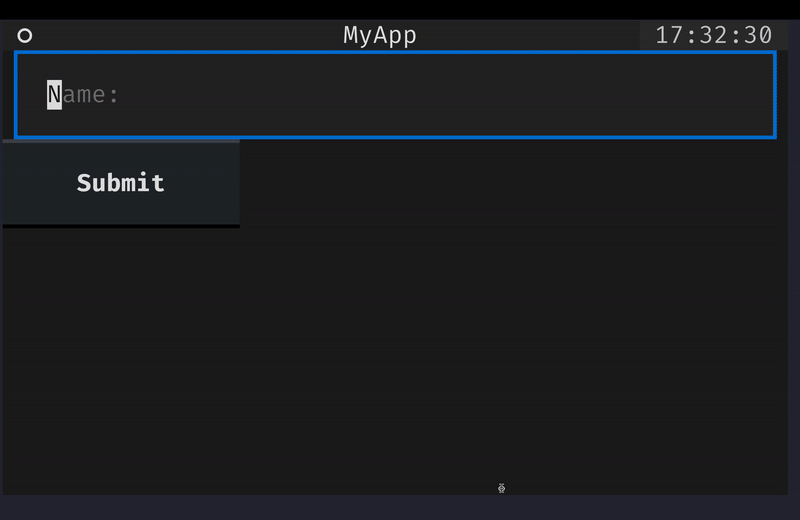
Querying a single widget and saving an explicit reference to that widget before composing it are typically two orthogonal approaches to managing widget interactions.
So far, we had been saving explicit references to all widgets we cared about as class variables.
Now, you can get to them with query_one.
Querying multiple widgets
Sometimes, your application will have more than one widget that matches the query.
When that is the case, using query_one will raise an error.
That happens because query_one expects exactly one widget in the app to match the selector given.
In all other cases you must use the method query.
This method returns an iterable with all the results.
On top of allowing iteration, the result of a query provides some useful methods to interact with all the results.
For example, the methods first and last can be used to access the first and last widgets that matched the query, respectively.
Here, we modified the previous app to include one more Input and then use query to access all inputs and their values:
from textual.app import App
from textual.widgets import Button, Header, Input, Label
class MyApp(App):
def compose(self):
yield Header(show_clock=True)
yield Input(placeholder="Name:")
yield Input(placeholder="Surname:")
yield Button("Submit")
def on_button_pressed(self):
data = " ".join(input.value for input in self.query(Input))
self.mount(Label(data))
MyApp().run()Workers
Workers are a life-changing feature that you will want to use for any app that uses some form of concurrency. In complex apps that interact with many external APIs, you will probably want to use workers.
The issue
There are also simpler cases where workers are really useful, for example when loading lots of data into your app. If you are not careful, you might write a loading method that blocks the interface while it is loading, which will make it look like it froze!
We're talking about this here for precisely the same reason. While it is unlikely that you will add enough TODO items to your app that loading them would take more than a split second, the type of application lends itself nicely to this pattern and so I will take this opportunity to show it.
Consider the application below that reads a file and creates a label for each line on the fly:
## import time
from textual.app import App
from textual.widgets import Button, Input, Label
class MyApp(App):
def compose(self):
yield Input(placeholder="filepath")
yield Button("Load!")
def on_button_pressed(self):
filepath = self.query_one(Input).value
self.load_data(filepath)
def load_data(self, filepath):
with open(filepath, "r") as f:
for line in f:
# time.sleep(2)
self.mount(Label(line.strip()))
MyApp().run()If the file being read is too big, there might be a significant amount of time during which nothing seems to happen in the application. What is more, you won't even be able to interact with the input field or the other widgets.
To see this in action, it suffices to add a call to time.sleep(2) inside the loop for line in f: and you will see the app frozen.
The decorator work
The decorator work will use a thread to circumvent this problem.
While the details of the inner workings are beyond my knowledge right now, I can tell you that fixing our loading is trivial:
## import time
from textual import work
from textual.app import App
from textual.widgets import Button, Input, Label
class MyApp(App):
def compose(self):
yield Input(placeholder="filepath")
yield Button("Load!")
def on_button_pressed(self):
filepath = self.query_one(Input).value
self.load_data(filepath)
@work
def load_data(self, filepath):
with open(filepath, "r") as f:
for line in f:
# time.sleep(2)
self.call_from_thread(self.mount, Label(line.strip()))
MyApp().run()We only needed to make two changes:
- we added the decorator
workaround the method that we want to not block the interface; and - we started using the method
self.call_from_threadinstead of calling the methodself.mountdirectly.
That's because most Textual methods aren't thread safe, so we need to use self.call_from_thread to schedule the method calls.
Even with the calls to sleep, the app above shouldn't block.
You should be able to interact with it while the application loads the file you pointed to.
The animation below shows this.
While there are two second intervals between each new label appearance, the remainder of the application remains responsive:
- the button style changes when I hover it;
- the input is still focusable; and
- I can edit the contents of the input.
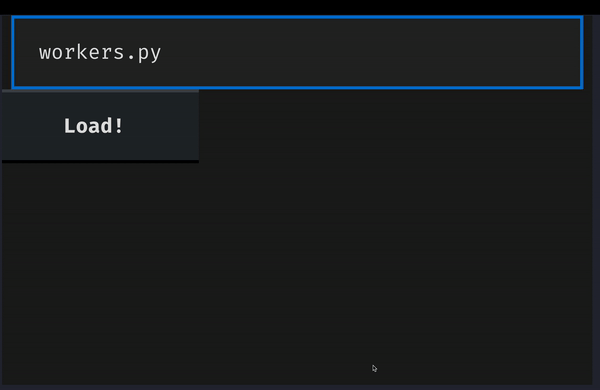
on_mount
Still thinking about the same problem, there will be times where you want to trigger a load action “as soon as possible” without the user having to intervene.
When that is the case, you will likely want to consider using the handler method on_mount.
When an app, a screen, or a widget is composed, that widget will receive a built-in event called Mount.
Thus, inside the handler on_mount is the earliest moment at which you know the widget was already put on the screen.
In an example similar to the previous one, if your data comes from a fixed source (for example, a specific file), you can call the load method from inside on_mount:
## import time
from textual import work
from textual.app import App
from textual.widgets import Label
class MyApp(App):
def on_mount(self):
self.load_data()
@work
def load_data(self):
with open("path/to/data", "r") as f:
for line in f:
# time.sleep(2)
self.call_from_thread(self.mount, Label(line.strip()))
MyApp().run()This is usually better than loading the data inside __init__, for example, because when something is initialised it doesn't mean it will be composed anytime soon, so we might be wasting resources if we start loading the data right away.
Finish your TODO app
This was the third and final stretch, where you learned about features such as Textual CSS, hot reloading, querying, workers, and the event Mount.
Now, I'd like you to use this knowledge to polish your TODO app:
- add data persistence to your app (keep it simple, like a JSON file or something of the sort); and
- style your app to make it look as awesome as you can.
In case you are not very imaginative, you can try to make your app look like mine, which I show below.
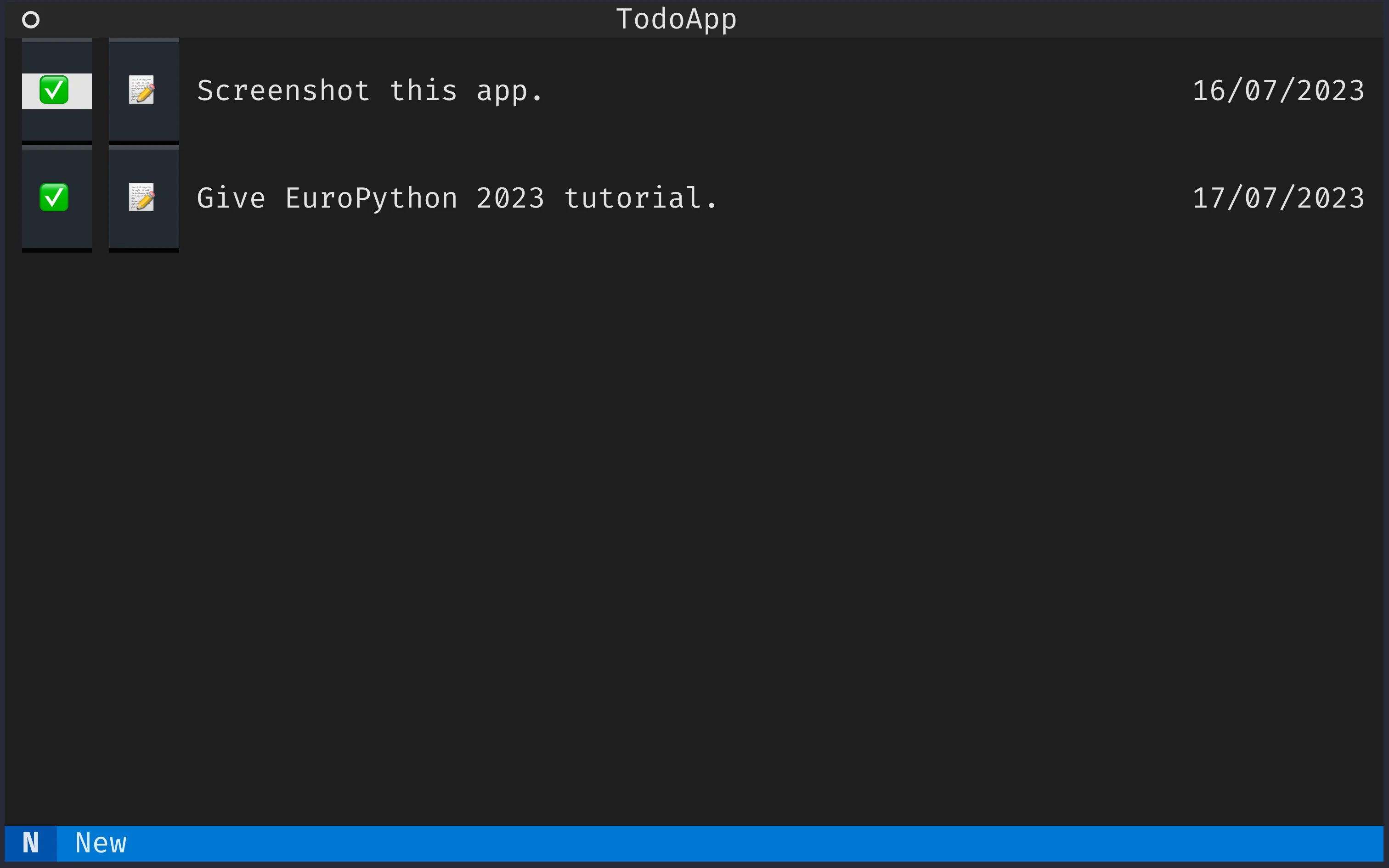

To make such short buttons, you will want to look at the style min-width.
Button sets a default value of 16, so you'll want to overwrite that with a smaller value.
To style the modal screen, it may also help to put all of the widgets inside a plain textual.containers.Container.
Final code
The final code for the app amounts to 130 lines of awesomeness:
from functools import partial
import json
from textual import on, work
from textual.app import App
from textual.containers import Center, Container, Horizontal
from textual.message import Message
from textual.reactive import reactive
from textual.screen import ModalScreen
from textual.widget import Widget
from textual.widgets import Button, Footer, Header, Input, Label
class TodoItemDetailsScreen(ModalScreen):
DEFAULT_CSS = """
TodoItemDetailsScreen {
align: center middle;
}
"""
def compose(self):
self.description_input = Input(placeholder="Description")
self.date_input = Input(placeholder="Due date dd/mm/yyyy")
with Container():
yield Label("Type description and due date in the format dd/mm/yyyy.")
yield self.description_input
yield self.date_input
with Center():
yield Button("Submit")
def on_button_pressed(self):
data = (self.description_input.value, self.date_input.value)
self.dismiss(data)
class TodoItem(Widget):
DEFAULT_CSS = """
TodoItem {
height: 2;
}
"""
description = reactive("")
date = reactive("")
class Edit(Message):
def __init__(self, item):
super().__init__()
self.item = item
class Delete(Message):
def __init__(self, item):
super().__init__()
self.item = item
def __init__(self):
super().__init__()
self.description_label = Label(id="description")
self.date_label = Label(id="date")
def compose(self):
with Horizontal():
yield Button("✅", classes="emoji-button", id="delete")
yield Button("📝", classes="emoji-button", id="edit")
yield self.description_label
yield self.date_label
def watch_description(self, description):
self.description_label.update(description)
def watch_date(self, date):
self.date_label.update(date)
@on(Button.Pressed, "#edit")
def edit_request(self):
self.post_message(self.Edit(self))
@on(Button.Pressed, "#delete")
def delete_request(self):
self.post_message(self.Delete(self))
class TodoApp(App):
BINDINGS = [("n", "new_item", "New")]
CSS_PATH = "todo.css"
def compose(self):
yield Header(show_clock=True)
yield Footer()
def on_mount(self):
self.load_data()
def action_new_item(self):
self.push_screen(TodoItemDetailsScreen(), self.new_item_callback)
def new_item_callback(self, data):
item = TodoItem()
description, date = data
item.description = description
item.date = date
self.mount(item)
def edit_item_callback(self, item, data):
description, date = data
item.description = description
item.date = date
def on_todo_item_delete(self, message):
message.item.remove()
def on_todo_item_edit(self, message):
self.push_screen(
TodoItemDetailsScreen(), partial(self.edit_item_callback, message.item)
)
@work
def save_data(self):
to_dump = [(item.description, item.date) for item in self.query(TodoItem)]
with open("data.json", "w") as f:
json.dump(to_dump, f, indent=4)
@work
def load_data(self):
with open("data.json", "r") as f:
loaded = json.load(f)
for description, date in loaded:
item = TodoItem()
item.description = description
item.date = date
self.call_from_thread(self.mount, item)
TodoApp().run()As for the CSS, this is what I have:
TodoItem > Horizontal > Label {
width: 1fr;
height: 1fr;
content-align: left middle;
}
TodoItem > Horizontal > #date {
width: 10;
}
TodoItem > Horizontal > * {
margin: 0 1;
}
TodoItem {
align: center middle;
height: 3;
}
TodoItemDetailsScreen {
align: center middle;
}
TodoItemDetailsScreen > Container > Label {
width: 100%;
padding-left: 1;
padding-right: 1;
}
TodoItemDetailsScreen > Container > Input {
margin: 1
}
TodoItemDetailsScreen > Container {
border: thick $background;
background: $boost;
width: 50%;
height: auto;
}
.emoji-button {
min-width: 4;
width: 4;
content-align: center middle;
}Further challenges
To conclude this tutorial, I'd like to leave you with a couple more challenges for you to tackle. None of these are extremely difficult from the technical point of view, but they will require some thinking and you will also probably have to look around in the documentation for missing pieces of the puzzle.
- Auto-fill the modal screen when you are editing a TODO item;
- Validate the date before dismissing the modal to prevent bad dates;
- Use Esc to dismiss modal screen, which should revert changes if you were editing an item and simply do nothing if you were creating a new item;
- Sort items by due date; and
- Add a separate tab where you keep all the items that have been completed already.
Take a crack at this and then let me know how you get on! You can share your progress, and eventually get some help, in the Textual Discord!
Become a better Python 🐍 developer, drop by drop 💧
Get a daily drop of Python knowledge. A short, effective tip to start writing better Python code: more idiomatic, more effective, more efficient, with fewer bugs. Subscribe here.
